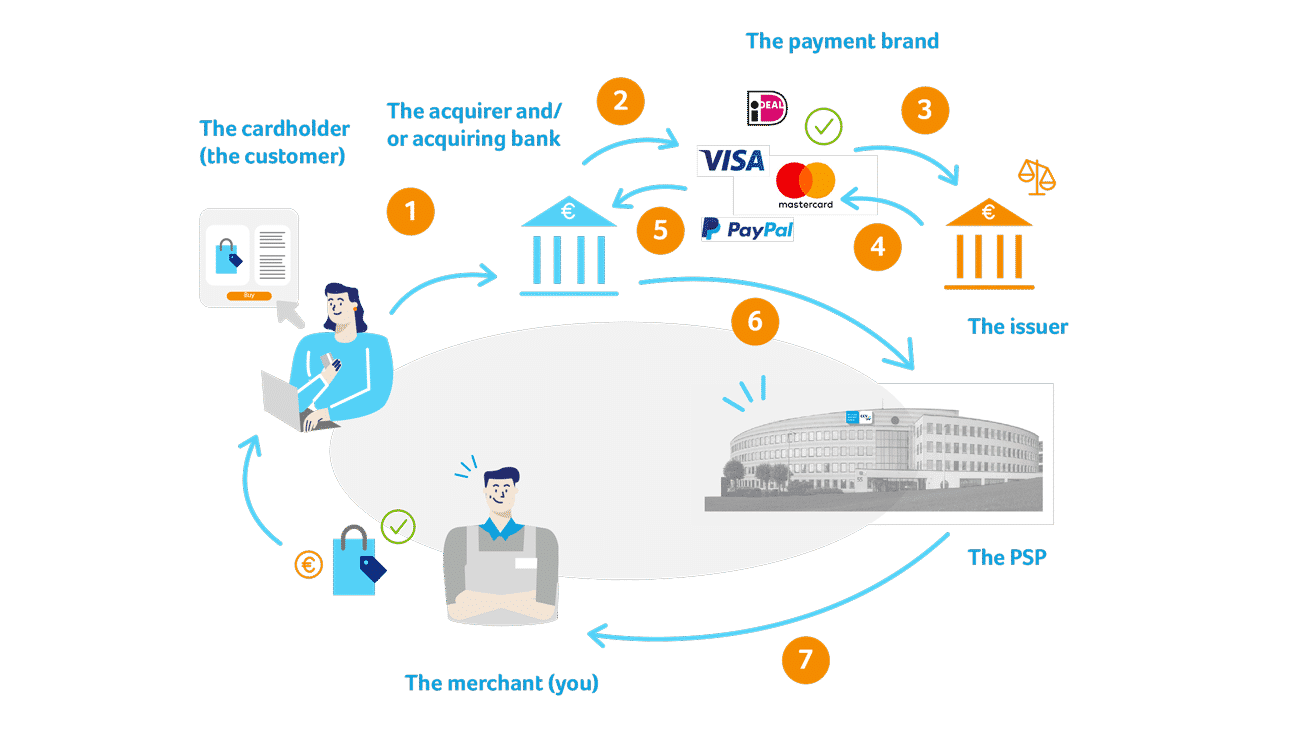Once limited to credit and debit cards alone, today, online payment is bursting at the seams with choice.
From mobile wallets like Apple Pay, Google Pay, and PayPal, to region-specific solutions like iDEAL (the Netherlands), Bancontact (Belgium), and Giropay (Germany and Austria) — not to mention a variety of vouchers and gift card schemes — your customers have an array of options at their fingertips to pay online.
But if you want to sell online, it’s helpful to understand how the process works and, more importantly, how money travels seamlessly from your customer’s bank account to yours.
In this post, we’ll explain who’s involved with each stage of online payment, how it all comes together, and the costs associated.
Who’s Involved with Online Payment?
When it comes to paying online, there are typically six parties involved:
- The cardholder (the customer)
- The merchant (you)
- A payment gateway (which handles the online transaction and sends the customer’s payment information to your payment processing company)
- The acquirer and/or acquiring bank (otherwise known as the “payment processing company”)
- The payment brand; the customer’s payment network or card network (i.e. Visa or PayPal – the network acts as a link between the acquirer and the card-issuing bank)
- The issuer (the bank that issues your customer’s credit or debit card – it checks to make sure the card is valid and that the customer has enough money to cover the transaction)
These six parties interact with one another as the transaction progresses, as we’ll see next.
Following the Online Transaction Flow
An online transaction essentially follows the same 7-step process each time. This covers customer authentication, sale completion, and payout to the merchant:
Step 1: A customer orders a product or service, and chooses to pay for it online through the merchant’s webshop. While doing this, the consumer enters their details and authenticates themself with a form of Strong Customer Authentication (SCA).
A Quick Note on SCA
Since the advent of the EU’s Revised Payment Services Directive (PSD2), Strong Customer Authentication has become part of the authorisation process for most online payments. Some low-value and low-risk payments are exempt, and so too are merchant-initiated transactions, subscriptions, and phone sales.
SCA prompts the customer to prove their identity with two of three things:
- something they know (e.g. password);
- something they have (e.g. device); and/or
- something they are (e.g. fingerprint or face).
This prevents fraud and ensures safe online transactions.
Step 2: The merchant passes the transaction details to the acquiring bank. If the merchant works with a Payment Services Provider (PSP), the merchant passes the data to the PSP, and they ensure that the acquirer is informed of the transaction details.
In the end, the PSP also ensures that the merchant receives their money.
Step 3: The acquiring bank passes on the transaction details to the issuing bank (the issuer).
Step 4: The issuing bank (the consumer’s bank) checks the transaction details and verifies if the payment details are correct and if there is enough balance to pay for the purchase.
Step 5: The issuing bank receives the approval or refusal from the merchant, and the payment gateway then provides confirmation of the sale to the customer and the merchant.
Step 6: The issuing bank will pass on its approval or refusal to the acquiring bank.
Step 7: The acquiring bank will ensure payout to the merchant. If the merchant works with a collecting PSP, the PSP will take care of the payout to the merchant.
What is a Payment Service Provider (PSP)?
A Payment Service Provider is a company that receives, authenticates, and processes electronic payments on behalf of merchants.
There are two types of PSP:
1. Collecting PSP: A collecting PSP collects all the online sales revenue from the different payment brands and acquiring banks in order to send it as one payment to the merchant. With this model, the merchant only has one contract, one point of contact, and one payout – just the PSP.
CCV is a collecting PSP for all brands that allow this model.
Note: PayPal doesn’t allow this, and pays the merchant directly.
2. Switching PSP: A switching PSP only takes care of the technical part of the transaction. This means that the merchant needs to have a contract with an acquiring bank, which will pay out the funds from online sales. This results in multiple points of contact and makes the process far more complex for the merchant.
Ready to Sell Online? Download The Ultimate Guide to Payment
Deciding to accept online payment brings with it a range of benefits for you and your customers, from the speed and convenience of anywhere, anytime purchasing, to future-proofing your business as the online shopping trend shows no sign of slowing down.
So, if you’d like to learn more about the ins and outs of online (and in-store) payment, we’ve put together a comprehensive guide on the subject.
In it, we cover online and electronic methods of payment, region-specific stats, and everything you need to know when choosing the best payment solutions for your business.
